
Hyalinobatrachium pellucidum, also known as the Rio Azuela glass frog, is a species of frog in the family Centrolenidae. It is found in lower montane rainforests on the Amazonian Andean slopes in Ecuador and Peru. The specific name pellucidum is Latin for "transparent" and refers to the transparent parietal peritoneum of this species.

Ranitomeya vanzolinii, also known as the Brazilian poison frog or spotted poison frog, is a species of frog from the family Dendrobatidae. It is found in the Amazonian rainforests of Brazil and Peru, and possibly Bolivia.

Hyperolius castaneus is a species of frogs in the family Hyperoliidae. It is found in the highlands of western Burundi, Rwanda, and Uganda as well as eastern Democratic Republic of the Congo. Common names of this species include Ahl's reed frog, brown reed frog, and montane reed frog. The status of the putative subspecies Hyperolius castaneus rhodogaster is unclear, and it may actually be a distinct species. Also Hyperolius constellatus, now a distinct species, was formerly recognized as a subspecies of H. castaneus.

Leptopelis flavomaculatus is a species of frog in the family Arthroleptidae. It is found in the lowlands eastern and southern Africa, from Mozambique north of the Save River and Zimbabwe to Malawi, eastern Tanzania, and coastal Kenya. Its common names are yellow-spotted tree frog, brown-backed tree frog, brown forest treefrog, and Johnston's treefrog.
Craugastor campbelli is a species of frog in the family Craugastoridae. The species is endemic to Guatemala.
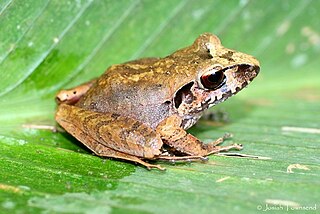
Craugastor laticeps is a species of frog in the family Craugastoridae. It is found in Belize, Guatemala, Honduras, and southern Mexico.
Craugastor phasma is a species of frog in the family Craugastoridae. It is endemic to southeastern Costa Rica and only known from its type locality in the Las Tablas protected area in the Puntarenas Province, near the Panamanian border. Only a single individual—the holotype collected in 1992—has ever been observed. It is unusual in its ghost-like, gray-white coloration, and it was initially thought that the specimen was an albino form of some other species. However, the specimen is also morphologically distinct, although some uncertainty regarding the validity of this species remains.
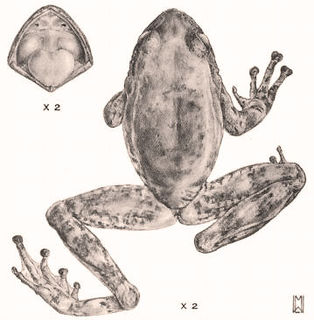
Cryptobatrachus boulengeri, also known as Boulenger's backpack frog, is a species of frogs in the family Hemiphractidae. It is endemic to Sierra Nevada de Santa Marta in northern Colombia. The specific name honours George Albert Boulenger, an eminent herpetologist.
Cryptobatrachus fuhrmanni is a species of frog in the family Hemiphractidae. It is endemic to Colombia and occurs on all three Andean cordilleras: it is found on the eastern slope of the Cordillera Occidental, northern and eastern flanks of the Cordillera Central, and the western slope of the Cordillera Oriental. The specific name fuhrmanni honors Otto Fuhrmann, Swiss zoologist and helmintologist.

Diasporus anthrax is a species of frogs in the family Eleutherodactylidae. It is endemic to Colombia where it is found along the eastern base of the Cordillera Central and the western slope of the Cordillera Oriental. The specific name anthrax is Greek for Greek, meaning a carbuncle, a red gemstone. It refers to the red patches on the hidden surfaces of the limbs.

Diasporus diastema is a species of frog in the family Eleutherodactylidae. Common names include common tink frog or dink frog, supposedly because of the loud metallic "tink" sound that the male frog makes during the night. It is found in Central America, from Honduras through Nicaragua and Costa Rica to Panama. Its natural habitats are tropical humid lowland forests and montane forests, but it can very disturbed habitats. It is found from sea level to 1,620 m (5,310 ft) elevation.
Diasporus quidditus is a species of frogs in the family Eleutherodactylidae. It is found in eastern Panama and northwestern Colombia. The specific name quidditus is derived from English word quiddity, which the describer John Douglas Lynch encountered in the book "Quiddities: An Intermittently Philosophical Dictionary" by Willard Van Orman Quine; he thought the name was apt because the species was small and had been confused with Diasporus vocator and Diasporus gularis.
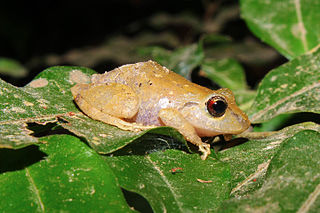
Pristimantis ridens, also known as the pygmy rain frog and the Rio San Juan robber frog, is a species of frog in the family Craugastoridae. It is found in western Colombia, and then through Panama and Costa Rica to Nicaragua and eastern Honduras.
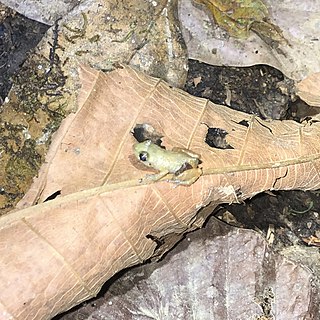
Diasporus vocator, sometimes known as Agua Buena robber frog after its type locality, Agua Buena, in Golfito canton of Costa Rica, is a species of frog in the family Eleutherodactylidae. It is found between southwestern Costa Rica and western Colombia on the Pacific versant and between central Panama and northern Colombia on the Atlantic versant. Its natural habitats are relatively pristine humid lowland and montaine forests, but it also occurs in secondary forest and tree plantations. It is threatened by habitat loss.
Niceforonia nana is a species of frog in the family Strabomantidae. It is endemic to the Cordillera Oriental, Colombia, and found at 3,000–3,850 m (9,840–12,630 ft) asl.
The Tonkin frog is a species of frogs in the family Ranidae. It is found in northern Vietnam and in adjacent southern China. The specific name is derived from Bac Bo, the Vietnamese name for northern Vietnam, as the species was first described from there.
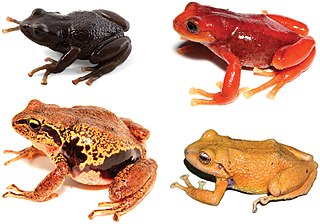
Craugastoridae, commonly known as fleshbelly frogs, is a family of New World direct-developing frogs. As delineated here, following the Amphibian Species of the World, it contains 123 species. They are found from the southern United States southwards to Central and South America.

Diasporus is a genus of frogs in the family Eleutherodactylidae. The genus was first described in 2008. They are found in Central and northern South America. They are sometimes referred to as dink frogs, in reference to the "tink" sound that males make during the mating season.

Gracixalus lumarius, also known as the thorny tree frog or thorny bushfrog, is a species of rhacophorid frog. It is endemic to Vietnam and only known from Mount Ngoc Linh in Ngoc Linh Nature Reserve, Kon Tum Province.
Diasporus ventrimaculatus is a species of dink frogs, in the genus Diasporus. It was originally described as Diasporus ventrimaculatus sp. nov. in Zootaxa in 2009.













